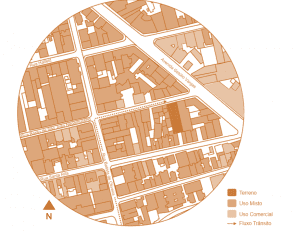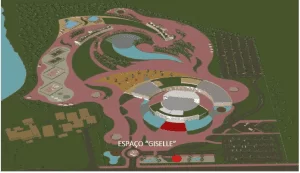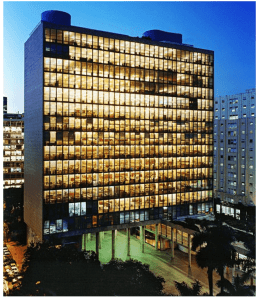FREITAS, Lucas Dornas de [1]
CASTILHO, Pedro Teixeira [2]
FREITAS, Lucas Dornas de; CASTILHO, Pedro Teixeira. The city as a space of citizenship: a reality in education? Multidisciplinary Core scientific journal of knowledge. Year 1. Vol. 9. Pp 648-658 October/November 2016. ISSN. 2448-0959
Summary
The knowledge of urban design is essential in the formation of the architect and urbanist to architect aware of interrelation between architecture and urbanism and the particular relationship and collective. Give the same importance to urbanism architecture is to have the commitment to the public space, the citizenship and the collective, ceasing the market growth and particularly about the collective.
Keywords: City – citizenship – public space – teaching of architecture and urbanism.
INTRODUCTION
When we refer to "Faculty of architecture and Urbanism" we conclude that the graduates for these colleges are qualified to practise the activity of architect and urbanist with the same capacity. This conviction is affected when we can assess the curricular grids presented and verified the usual practices of professionals, more directed to the design of the building for the urban boundary.
For many the city is a set of buildings, for others, it's a set of people. But, what makes a set of buildings and people being appointed city? What sets it apart from a mere village? The difference between a town and a village is not only quantitative. In a brief and objective concept, Allix (1956) characterizes the town as a human group supplied from overseas, where most of the residents dealing with various farm activities or pastoral. What characterizes a city is not the number of individuals who live there, but they exert, as well as the way you do.
The city can be regarded as the most severe interference in the environment. Can be perceived as the synthesis of civilization, whose lifestyle traverses not only its structure, but the entire its region of influence, modeling an urban universe beyond its borders. The city is the place where man can improve their intellectual skills, given the coexistence of multiple social groups; Therefore, a place where you can engage in extended mode the option of a distinct lifestyle and thus freedom.
However, the city at the same time promoting the growth of civilization, since it requires, in the arduous task of creating child-friendly spaces, social humanitarian relations requires a social action increasingly enhanced, in which the differences can be resolved gradually more egalitarian way, straighter, more tired, especially culturally, more healthy and sustainable.
CITIZENSHIP
The word "citizenship" derives from the Latin civitas meaning city. In classical antiquity, the citizen was one who lived in the cities and their social relations were based on common rights and duties. The stems of the years, citizenship has been perceived as an aggregate of rights. The concept of equal rights turned the previous society, established on the concept of unequal status. Citizenship established a common code of rights and, although some hierarchical differences remain, as the differences between social classes, race and gender, citizenship means that, still, citizens share equal rights and duties. Freedom and diversity in cities only did expand those rights.
However, not all persons residing in the cities also take advantage the right to the city, seen as a decent life and with access to all that she provides, such as the right to freedom to come and go, to express a point of view, to produce, to study, to live decently and have access to culture in its most varied ways.
Between us citizenship if established in a hierarchical manner, a contradiction to the concept of equality that she assumes. To understand it in its daily manifestations, it was necessary to create weird settings as subcidadãos or hipercidadãos, regulated citizenship, citizens in negative, estadania, among many others. Weird, but indispensable for the understanding of our constant differences. Although no one should ignore the transformations and victories, many essential differences, and not only differences persist. And, if you linger, citizenship cannot be complete, since the practice for a presumes the practice of others. The right to culture assumes the enjoyment of civil rights, is related to the free expression of opinion, with the right to come and go, and, consequently, free access to the various places of the city. This, as far as you're concerned, assumes the right to decent life and the insertion in the city. Have the right to political participation if favors and complements with the right to education and knowledge.
To which rights can be exercised in full form, requires that are established legally – which gives transparency and protection. But they need also to be experienced: citizens must have science and conditions to exercise them. The legal warranty is a step that needs to be completed with the exercise, the practice of law.
Therefore, the Act of the city group the producers and actors of culture and also their large organizations does not mean that everyone has full access to culture. To ensure such access goes through a process of social and political change. In the political context it is vital that the verdicts about the cultural life contains with the activities of the various social actors. In the social context, our cities must be more egalitarian in their space, to provide coexistence instead of separation. Spatial discrimination that marks our cities is a physical and social blockade for many rights, besides being a way of multiplication of differences.
Though the repetition of the subject of deterritorialization, what you see in some territories of the Brazilian capital is the existence of social groups with little physical mobility power by virtue of the metropolitan and distances its spending, but also the difficulties of living with other groups and spaces, thereby becoming prisoners of their place of residence. Overcome these obstacles is a challenge for the public managers, decentralise the culture is another. In these two cases what we realize is the importance of culture and its challenges: neither prisoners nor exclusive Submissives one space.
Finally, the space is an essential component of the identification of the citizens with the cities, both in their public spaces, such as plazas and parks, in their referential buildings of different ways of living, in the neighborhood or even in their homes. In structuring our identity several senses engaged the US role call to individuals, to things and events, but the space stands out. Is through the memory of the places our experiences record in memory and our feelings. Be a part of a city, a State or a country is not only a legal status, but, above all, the sharing of experience and the experience of the locations. It comes from the importance of maintaining the most expressive locations of the city as a way to strengthen the call for the identification and commitment of citizens to the city.
The present understanding of cultural heritage, in the place of historical and artistic heritage, is incorporation process indicator for this public policy, material and immaterial cultural events and various social groups that form the brazilian collective. The introduction of the city on world heritage protection, particularly since the Constitution of 1988, give concreteness to this expansion, in addition to the wealth of the daily life of the inhabitants of the cities, connecting to their identities.
If the claim that the city is a place of freedom, citizenship and culture if it contradicts with our reality, not its image, the assertion that belief and that theory is the basis of our actions in the world.
CITY AND CITIZENSHIP
Citizenship represents a set of inherent rights and duties of the person in the face of the State and society, which determine the democracy. Citizenship is based on the principles of law and equality: all are equal before the law and everyone has the right to act, directly or indirectly, of the process of creation of these same laws (political participation). Citizenship includes also social rights or, as stated by Marshall (1967), the "right to participate completely in the social heritage, and lead the life of a civilized being according to the standards that prevail in society. ”
Regarding citizenship education, Fernandez, Miranda and Alexander (2002) confirm that citizenship is not just a lot of rights, but it also covers the conscious involvement in public life and in social life, in which a citizen "must develop in order to fight for social integration, environmental conservation, social justice, solidarity, security, tolerance, civil society statement versus arbitrary of power" (FERREIRA; MIRANDA; ALEXANDER, 2002, p. 2.3).
Thus, the city must be the location of the full exercise of citizenship. That means, not only the city must ensure the means for the human being to grow culturally and material, but that their city should be a result of aspiration and of all its citizens. In this way, the urban development policy must be a product of this exercise.
The status of the city determines that the social function of property and the right to the city are the principles of urban policy. What does that mean? Firstly, it means the public interest prevails over private interests and that the urban property must adapt to the common welfare and social justice (BRAZIL, 2002).
The establishment of the status of the city and the exercise of the social function of property require an essential tool: the master plan. This is the basic tool of urban policy, required by the Constitution of 1988 to all municipalities with more than 20000 inhabitants. The master plan is a law, approved by City Council, which determines the guidelines for the urban growth (delimitation of urban area and urban expansion, i.e., which way the city should expand), to the urban zoning (land use management: appropriate areas for the Foundation of industries, commercial areas, residential buildings, housing clusters etc.), for the establishment of allotments , for the agrarian regularization (illegal building, slums, tenements, etc.) and everything concerning the growth and development of the city (BRAZIL, 2002).
The status of the city establishes that, in the development of the master plan, must occur, in any event, the involvement of citizens, directly and indirectly, through their associations representatives. Should be made the city's conferences, debates and public hearings and studies, diagnoses and proposals made should be widely published by the communication tools, so everyone can act on equal terms (BRAZIL, 2002).
The right to the city means more than the right to housing, the right to a decent life including all the things a city can provide: schools, health centers, hospitals, parks, green areas, water, sewage, waste collection, in short, all devices and social conditions that can make urban life healthy and protected.
The structuring of a city of all and for all requires a constant Conference of political debates and a social agenda that is expressed in laws, plans and actions.
TEACHING OF ARCHITECTURE AND URBANISM
A common curricular grids censorship in force in schools of architecture and urban design is about the fragmentation and compartmentalisation of affairs courses. Normally, courses and its disciplines are brought together by departments or "knowledge industries" which is presented as a pretext to questions of quality of vocational training in this.
Another problem is the lack of interest of students in study and meet the urban design, with its causes in the dynamics, logical and also events of modernity. The collective gradually is guided by the process of atomisation and individualization, in which private interests are more important than public interests. The entities until then creators of opinions are challenged: the family, the religion and the State. The market progresses as forming reference. Thus, establishes the individual freedom, instant pleasure and at the same time the speed, change and brevity. The NET world firms and the market grows over the various areas of human experience.
Give the same importance to urbanism architecture is to call the engagement with public space, citizenship and the collective for the architect, stopping the progress of the market and particularly about the collective. Is to engage the professional in creating the city's constant and thus the teaching of new urbanism.
A qualified Architect to understand the urban design can make criticisms and to build appropriate and high-quality public spaces – spaces able to resume the use and the collective experiences in cities increasingly marked by indifference and little-if the public areas. I mean, the architect becomes a subject knowledgeable of your function participant in creation of the city and its territories.
At this time, the knowledge of urban design and conduct criticism appear as stimulators of new shares and new compromises – are an open field to the rescue of the importance of public space and the creation of a professional ethics engaged with the composition of the city, the welfare of its residents and future generations. It is under this conception that reconsidered the teaching of urban design today can bring new perspectives according to the faculties, their teachers and students. So, you wish, through the recognition of urban design, place and bring the scene to architect-urbanist function as an indispensable actor in the structuring of city space equally.
REFERENCES
ALLIX, André. Geography manual general: Physics, human y. Madrid: Ediciones Rialp, 1967.
Brazil. Law nº. 10,257 of 10 July 2001. The city status and Related Legislation. 2. Ed., current. Brasilia: Federal Senate, Secretariat for technical issues, 2002. 80 p. available at: <http: www.geomatica.ufpr.br/portal/wp-content/uploads/2015/03/estatuto-da-cidade.pdf="">.</http:> Access in: 6 set. 2016
FERREIRA, M. M.; MIRANDA, B. M.; Alexander. Education for citizenship: current trends. Tetsdais-Active Citizenship, Sustainable development and cultural diversity, 2002.
FISCHER, Sylvia. Myths and prospects: profession of architect and architectural education. Magazine design, Rio de Janeiro, 1995.
MARSHALL, t. h. citizenship, social class and status. Rio de Janeiro: Zahar, 1967.
NUNES Debora. The training of architects. In: NUNES, Debora (prg.). Salvador: the architect and the informal city. Salvador: PPG-FAUFBA/LabHabitar, 2000, 216p.
[1] Pythagoras School. Department of architecture and urban design
[2] UFMG. Department of psychology






